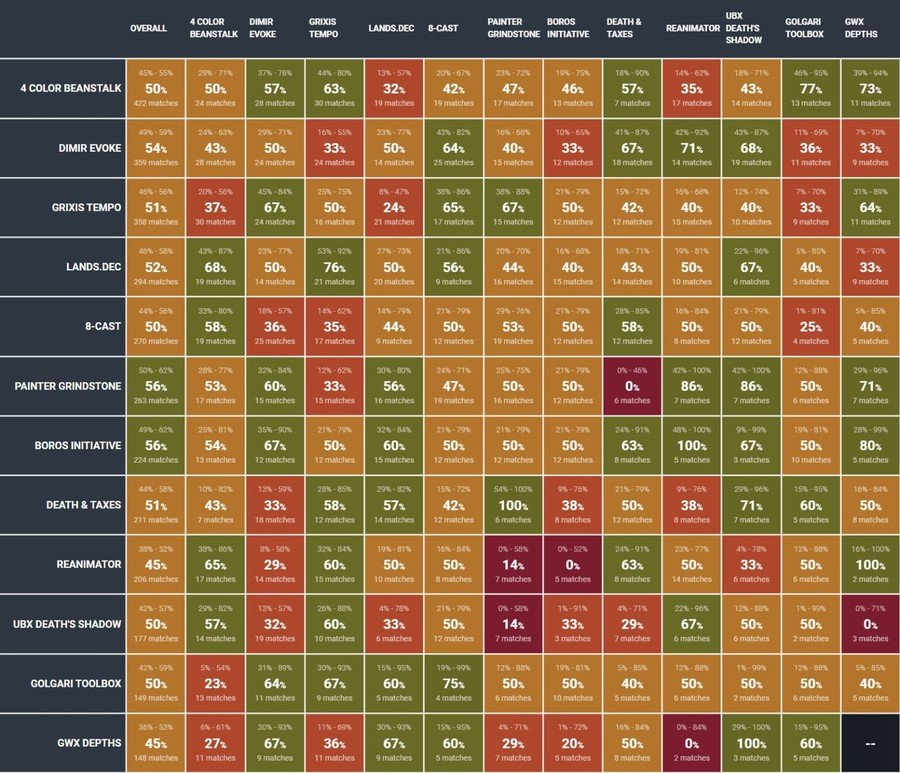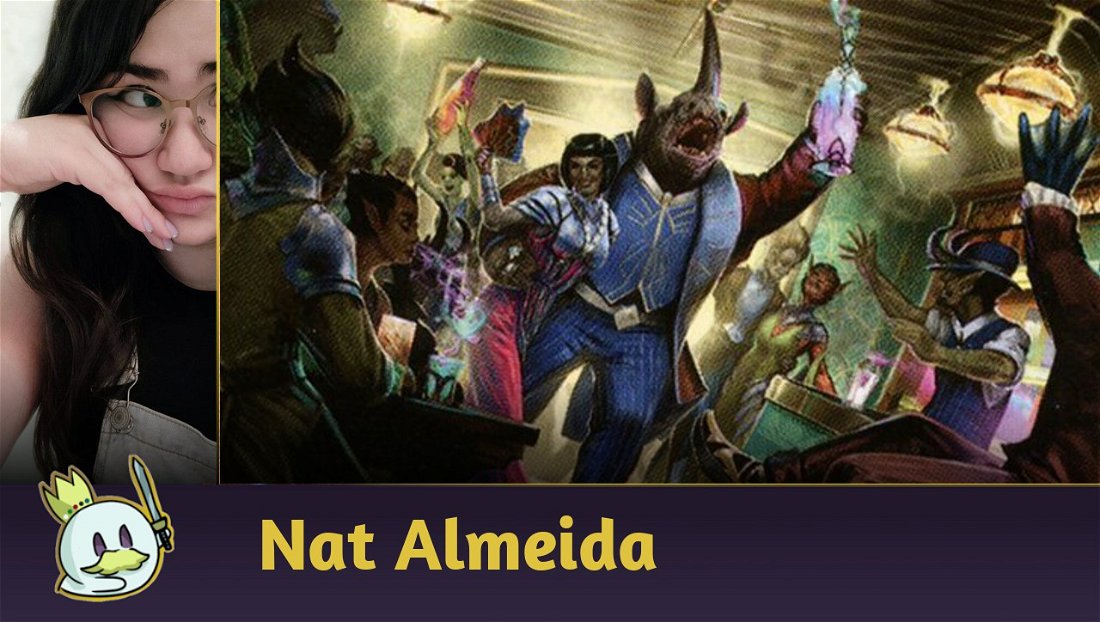Introduction
Hello, Legacy enthusiasts! On the weekend of November 18-19, 2023, the European leg of the Eternal Weekend took place in Prague, Czech Republic.
On Saturday, we witnessed the Legacy event with 713 players, and on Sunday, the Vintage event with 125 players. This tournament, comparable to a Grand Prix in scale, provided us with a comprehensive view of the format's landscape, given the large number of games played. This allowed for a more grounded assessment of the performance among different archetypes, with the variance being diluted across a greater number of matches. Let's delve into what insights this massive tournament brought us.
Ad
Weekend Meta
Since the tournament was conducted on Melee.gg, we have access to the lists, archetypes, and pairings of the 713 players, offering a true snapshot of the Legacy scene.
Some information required a bit of work, as certain archetypes were listed under different names – 4-Color Snowko? Oko is not even valid! – but we managed to group them for analysis:
• Uro Control (Bant, 4-Color, and 5-Color): 57 decks (7.99%)
• Grixis Delver: 40 decks (5.61%)
• Dimir Scam: 37 decks (5.19%)
• 8-Cast: 34 decks (4.78%)
• Lands: 32 decks (4.48%)
• Boros Initiative: 31 decks (4.34%)
• Storm: 28 decks (3.93%)
• Death’s Shadow: 27 decks (3.80%)
• Death and Taxes: 25 decks (3.51%)
• Dark Depths (Abzan, Selesnya, Golgari, and Naya): 24 decks (3.36%)
• Painter (Monored, Rakdos, and Boros): 24 decks (3.36%)
• Cradle Control: 18 decks (2.53%)
• Burn: 18 decks (2.53%)
• Life from the Loam: 17 decks (2.38%)
• Doomsday: 16 decks (2.25%)
• Temur Aggro (Delver/Delverless): 15 decks (2.10%)
• Cephalid Breakfast: 14 decks (1.97%)
• Rhinos Cascade: 14 decks (1.97%)
• Sneak and Show: 12 decks (1.69%)
• Red Prison: 11 decks (1.54%)
• Maverick: 9 decks (1.26%)
• Jeskai Control: 9 decks (1.26%)
• Other Archetypes: 201 decks (28.19%)
It's evident that Legacy is currently in a diverse phase of its history, with a mix of Control, Aggro, Combo, and Prison evenly spread. No archetype surpasses the 8% mark. These numbers align well with the metagame analyses from smaller tournaments and online events, indicating no outliers in this tournament.
Top 8
Reflecting the diversity of the tournament, the Top 8 was also quite varied, with the only "repeated" archetype being the two versions of Temur Aggro (Canadian Threshold): one more aggressive with Delver of Secrets, the other more Midrange to extract value from Up the Beanstalk. Let's now explore the top-performing decks:
Champion
The champion of this massive tournament was Julian Jakobovits with the reliable Temur Delver. For a long time, Izzet Delver reigned supreme in the format, but the banning of Expressive Iteration prompted players to seek alternatives to regain card flow.
A card that appeared in several lists was Reckless Impulse, but Wilds of Eldraine brought something better: Questing Druid! This offspring of Quirion Dryad and Reckless Impulse not only provides the extra gas the deck sought but also presents the option of a creature that grows rapidly in this deck. Thus, Temur Delver returned as a threat in the format, completely abandoning the retired Tarmogoyf.
Runner-Up
Directly from Modern to Legacy, we have Ergzpo's Rhino Cascade. The plan here is simple: put two 4/4 Rhinos for 3 mana via Cascade spells, and if that fails, resort to the Hamster Token from Minsc & Boo, Timeless Heroes.
Ten Counterspells that don't interfere with Cascade, coupled with Brazen Borrower and Fire//Ice, are used to control the game.
Ad
Top 4
In the top 4, we have two decks with Underground Sea, but the lists couldn't be more different. Player Marc Tobiasch opted for Doomsday, which I consider the most challenging deck to pilot in the format.
Noteworthy in the list are the main deck Veil of Summer, considering a format with many counters and discard spells, and 3 The One Ring, which not only buys time but also finds the combo pieces.
Elves used to be a formidable deck in the format, but then it took an arrow to the knee. The engine of Glimpse of Nature and Heritage Druid simply couldn't withstand the onslaught of Orcish Bowmasters. However, the other part of the deck, abusing the obscene mana generated by Gaea’s Cradle and cheating monsters into play via Natural Order, was still too good to be abandoned.
Thus, players shifted away from most Elves for a more Midrange list centered around Fiend Artisan, giving rise to Cradle Control. This list was used by Donderillo to reach the finals.
Top 8
On the other hand, player spartan117 chose to go with the second most popular deck in the format, the Delver version that gained strength with the arrival of Orcs, Grixis. This list is the first among those presented here to incorporate a card from Ixalan, Molten Collapse.
Finally, we have here a unique Reanimator list. It's actually a hybrid version of Reanimator with Rakdos Scam. It can attack from various angles, whether by quickly reanimating Atraxa, Grand Unifier or even Troll of Khazad-dûm, by the attacking duo of Grief + Reanimate, or by ambushing a Brainstorm with an Orcish Bowmasters.
Other interesting additions include Urza’s Saga, which finds Currency Converter in the main deck, and Shadowspear, Pithing Needle, and even Engineered Explosives in the sideboard. Closing this unusual list is Liliana of the Veil.
Next is my beloved Boros Initiative, piloted by Peter Lobotka. There are no innovations in the main deck, as it is the archetype's standard list. In the sideboard, he innovated with 2 Null Rod, considering the significant presence of 8-Cast and Storm decks, which seems to have been a wise choice.
Closing the Top 8 decks is the second Temur, used by Gazzo91. This list forgoes the aggression of Insectile Aberration to generate value with Up the Beanstalk, fueled by Force of Will, Murktide Regent, Ethereal Forager, and Lórien Revealed. Once again, Questing Druid serves the dual purpose of keeping the deck moving forward and posing a threat.
Winrate Analysis
The folks at MTGdecks compiled the 5385 registered games and generated a spreadsheet with the overall winrates of the main archetypes in the tournament, along with a matrix depicting their performance against each other. At the top of this index, two Ancient Tomb decks stand out: with a 56% overall winrate, we have the Painter’s Servant with Grindstone combo decks and the Boros Initiative, followed by Dimir Scam with 54% and Lands with 52%.
Ad

On the opposite end of the spectrum, considering only the most popular decks of the tournament, we find Reanimator and Selesnya/Abzan Depths, with only a 45% win rate. In the intermediate range, with 50 to 51%, we have Uro Control, Grixis Delver, 8-Cast, Death & Taxes, Death’s Shadow, and Cradle Control.
The complete matrix of each archetype's performance can be found here.
This demonstrates that the format is balanced not only in terms of popularity but also in performance indices. Although these two archetypes excelled in such a tournament, it's not conclusive that they are outliers, nor does it mean those that performed below are worthless. However, it's worth keeping an eye on how they will fare in the Japanese and American legs of the Eternal Weekend.
Conclusion
It's truly a unique opportunity to have access to such a volume of information and learn more about our format. Best regards, and I hope you enjoyed it! Until next time!









— Comments0
Be the first to comment